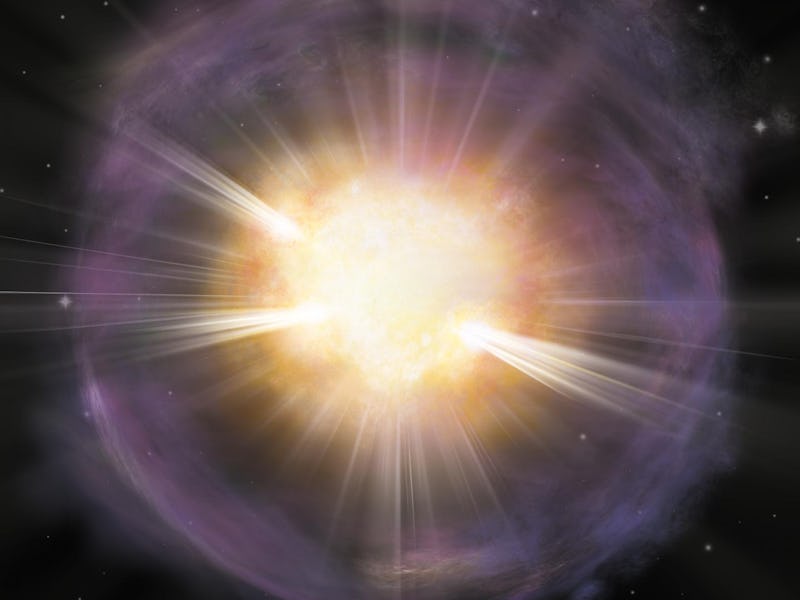Your bones are made from a supernova
Calcium-rich explosions dot the Universe. One discovery in Seattle led to a worldwide race to learn more.

A supernova first detected in 2005 changed humanity’s perception of the Universe, and one of the minerals needed to support life — calcium.
Researchers eventually determined that the explosion, and ones like it, were responsible for the high abundance of calcium in the Universe, including all calcium on Earth, which includes your bones.
Now, scientists have been able to study one of the mysterious “calcium-rich supernovae” with X-rays for the first time.
Calcium-rich supernovae were first announced to the world a decade ago when a low-mass white dwarf exploded. White dwarfs are stars that have been compacted into around the size of planets, creating immense amounts of pressure. Already in a delicate balance, this white dwarf was siphoning off helium from a sister star. There’s a limit to the mass a white dwarf can attain, around 1.4 times the mass of the Sun.
Too much helium created a violent shockwave, possibly destroying the star and creating an explosion that could be detected 100 million light-years away on Earth. Scientists calculated that half of the mass ejected through the explosion was calcium, and a new subclass of supernova was born.
An artist's depiction of a white dwarf siphoning off matter from a larger binary star, sealing its own fate.
Ten years later, their mysteries still befuddle scientists like Wynn Jacobson-Galan, a first-year Northwestern graduate student who led the current study (here is the preprint), published in Astrophysical Journal. Speaking in a press statement, Jacobson-Galan noted that these explosions “are so few in number that we have never known what produced calcium-rich supernova."
That’s why Jacobson-Galan’s team chose to explore Supernova (SN) 2019ehk, which scientists have noticed shows similarities in terms of origin with other calcium-rich explosions. The team believes that in its former life, SN 2019ehk was likely a white dwarf or a low-mass massive star.
X-ray imaging has revealed several concrete facts about these explosions, most notably how they create their calcium. A calcium-rich supernova is, in fact, a compact star that sheds an outer layer of gas during its last life stages. The matter within the star collides with the star’s outer shell, which is mostly helium and hydrogen, heated up to around 100,000 degrees Fahrenheit.
When the matter within and the outer shell collide, they begin a rapid chemical reaction that creates calcium, the most abundant mineral in the human body.
"In the world of transients, we have to discover things very, very fast."
Temporary events, like the explosion of SN 2019ehk and its aftermath, are described in the world of astronomy as “transients.” After SN 2019ehk was discovered by an amatuer astronomer in Seattle peering into the Messier 100 spiral galaxy, international science jumped into action. Speaking to the vast nature of space, the Hubble Space Telescope has observed Messier 100 for 25 years, but never captured an image of star that exploded into SN 2019ehk.
Raffaella Margutti, an astrophysicist and senior author of the study, says that time was of the essence.
"In the world of transients, we have to discover things very, very fast before they fade. Initially, no one was looking for X-rays. Daichi [Hiramatsu, a grad student at the University of California Santa Barbara] noticed something and alerted us to the strange appearance of what looked like X-rays. We looked at the images and realized something was there. It was much more luminous than anybody would have ever thought. There were no preexisting theories that predicted calcium-rich transients would be so luminous in X-ray wavelengths."
All calcium originates from the stars. With the help of the W.M Keck Observatory in Hawai’i, home of the world’s largest optical and infrared telescopes, the Northwestern team was able to figure out that SN 2019ehk was the largest single emission of calcium ever recorded.
Margutti says that "it wasn't just calcium-rich. It was the richest of the rich."
Abstract: We present panchromatic observations and modeling of the Calcium-rich supernova 2019ehk in the star-forming galaxy M100 (d≈16.2 Mpc) starting 10 hours after explosion and continuing for ~300 days. SN 2019ehk shows a double-peaked optical light curve peaking at t=3 and 15 days. The first peak is coincident with luminous, rapidly decaying Swift-XRT discovered X-ray emission (Lx≈1041 erg s−1 at 3 days; Lx∝t−3), and a Shane/Kast spectral detection of narrow Hα and He II emission lines (v≈500 km/s) originating from pre-existent circumstellar material. We attribute this phenomenology to radiation from shock interaction with extended, dense material surrounding the progenitor star at r<1015 cm and the resulting cooling emission. We calculate a total CSM mass of ∼7×10−3M⊙ with particle density n≈109cm−3. Radio observations indicate a significantly lower density n<104cm−3 at larger radii. The photometric and spectroscopic properties during the second light curve peak are consistent with those of Ca-rich transients (rise-time of tr=13.4±0.210 days and a peak B-band magnitude of MB=−15.1±0.200 mag). We find that SN 2019ehk synthesized (3.1±0.11)×10−2 M⊙ of 56Ni and ejected Mej=(0.72±0.040) M⊙ total with a kinetic energy Ek=(1.8±0.10)×1050 erg. Finally, deep HST pre-explosion imaging at the SN site constrains the parameter space of viable stellar progenitors to massive stars in the lowest mass bin (~10 M⊙) in binaries that lost most of their He envelope or white dwarfs. The explosion and environment properties of SN 2019ehk further restrict the potential WD progenitor systems to low-mass hybrid HeCO WD + CO WD binaries.
This article was originally published on